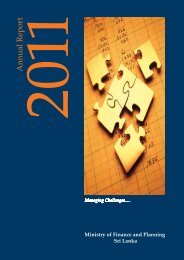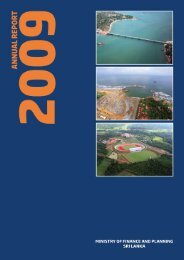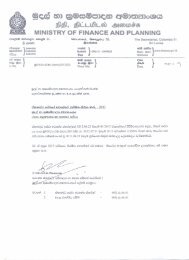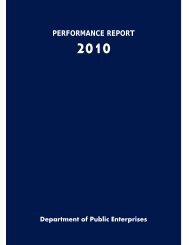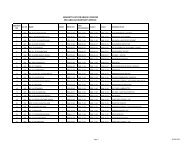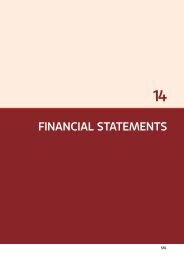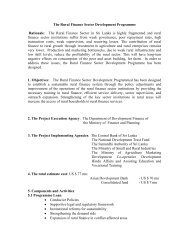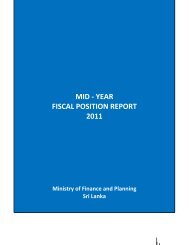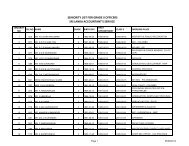- Page 4 and 5: Ministry ofFinance and Planning(as
- Page 6 and 7: Heads ofDepartments under thePurvie
- Page 8 and 9: ContentsChapter 1 Development Persp
- Page 10 and 11: Chapter 5 Foreign Financing 243Over
- Page 12: Ministry of Finance and Planning Sr
- Page 15 and 16: SRI LANKA AT A GLANCE - 2005 & 2010
- Page 17 and 18: BRIEFINGSBriefings“Much remains t
- Page 20: Ministry of Finance and Planning Sr
- Page 23: 1 | DEVELOPMENT PERSPECTIVESEconomi
- Page 27 and 28: 1 | DEVELOPMENT PERSPECTIVESThe Ser
- Page 29 and 30: 1 | DEVELOPMENT PERSPECTIVESMeanwhi
- Page 31 and 32: 1 | DEVELOPMENT PERSPECTIVESBox 1.1
- Page 33 and 34: 1 | DEVELOPMENT PERSPECTIVESDecline
- Page 35 and 36: 1 | DEVELOPMENT PERSPECTIVESThe inc
- Page 37 and 38: 1 | DEVELOPMENT PERSPECTIVESSince 1
- Page 39 and 40: 1 | DEVELOPMENT PERSPECTIVESBox 1.2
- Page 42 and 43: Ministry of Finance and Planning Sr
- Page 44 and 45: Ministry of Finance and Planning Sr
- Page 46 and 47: Ministry of Finance and Planning Sr
- Page 48: Ministry of Finance and Planning Sr
- Page 53 and 54: 1 | DEVELOPMENT PERSPECTIVESThe inc
- Page 55 and 56: 1 | DEVELOPMENT PERSPECTIVESDevelop
- Page 57 and 58: 1 | DEVELOPMENT PERSPECTIVESChart 1
- Page 59 and 60: 1 | DEVELOPMENT PERSPECTIVESContd..
- Page 61 and 62: 1 | DEVELOPMENT PERSPECTIVESAviatio
- Page 63 and 64: 1 | DEVELOPMENT PERSPECTIVESTable 1
- Page 65 and 66: 1 | DEVELOPMENT PERSPECTIVESWater S
- Page 67 and 68: 1 | DEVELOPMENT PERSPECTIVESIn orde
- Page 69 and 70: 1 | DEVELOPMENT PERSPECTIVEStender
- Page 71 and 72: 1 | DEVELOPMENT PERSPECTIVESThe gov
- Page 73 and 74: 1 | DEVELOPMENT PERSPECTIVES• Nor
- Page 75 and 76: 1 | DEVELOPMENT PERSPECTIVESPropose
- Page 77 and 78: 1 | DEVELOPMENT PERSPECTIVESContd..
- Page 79 and 80: 1 | DEVELOPMENT PERSPECTIVESHealth
- Page 81 and 82: 1 | DEVELOPMENT PERSPECTIVESTable 1
- Page 83 and 84: 1 | DEVELOPMENT PERSPECTIVESHospita
- Page 85 and 86: 1 | DEVELOPMENT PERSPECTIVESThe pro
- Page 87 and 88: 1 | DEVELOPMENT PERSPECTIVESBox 1.8
- Page 89 and 90: 1 | DEVELOPMENT PERSPECTIVESNo.Tabl
- Page 91 and 92: 1 | DEVELOPMENT PERSPECTIVESChart:
- Page 93 and 94: 1 | DEVELOPMENT PERSPECTIVESNumber
- Page 95 and 96: 1 | DEVELOPMENT PERSPECTIVESEnviron
- Page 97 and 98: 1 | DEVELOPMENT PERSPECTIVESan incr
- Page 99 and 100:
1 | DEVELOPMENT PERSPECTIVESBox 1.9
- Page 101 and 102:
1 | DEVELOPMENT PERSPECTIVESTable 1
- Page 103 and 104:
1 | DEVELOPMENT PERSPECTIVESTable 1
- Page 105 and 106:
1 | DEVELOPMENT PERSPECTIVESIndustr
- Page 107 and 108:
1 | DEVELOPMENT PERSPECTIVESIn addi
- Page 109 and 110:
1 | DEVELOPMENT PERSPECTIVESTable 1
- Page 111 and 112:
1 | DEVELOPMENT PERSPECTIVESelectri
- Page 113 and 114:
1 | DEVELOPMENT PERSPECTIVESWelfare
- Page 115 and 116:
1 | DEVELOPMENT PERSPECTIVESEnhance
- Page 117 and 118:
1 | DEVELOPMENT PERSPECTIVESEnding
- Page 119:
1 | DEVELOPMENT PERSPECTIVESBox 1.1
- Page 122 and 123:
Ministry of Finance and Planning Sr
- Page 124 and 125:
Ministry of Finance and Planning Sr
- Page 126 and 127:
Ministry of Finance and Planning Sr
- Page 128 and 129:
Ministry of Finance and Planning Sr
- Page 130 and 131:
Ministry of Finance and Planning Sr
- Page 132 and 133:
Ministry of Finance and Planning Sr
- Page 134 and 135:
Ministry of Finance and Planning Sr
- Page 136 and 137:
Ministry of Finance and Planning Sr
- Page 138 and 139:
Ministry of Finance and Planning Sr
- Page 140:
Ministry of Finance and Planning Sr
- Page 143 and 144:
1 | DEVELOPMENT PERSPECTIVESWagesIn
- Page 146 and 147:
Ministry of Finance and Planning Sr
- Page 148 and 149:
Ministry of Finance and Planning Sr
- Page 150 and 151:
Ministry of Finance and Planning Sr
- Page 152 and 153:
Ministry of Finance and Planning Sr
- Page 154 and 155:
Ministry of Finance and Planning Sr
- Page 156 and 157:
Ministry of Finance and Planning Sr
- Page 158 and 159:
Ministry of Finance and Planning Sr
- Page 160 and 161:
Ministry of Finance and Planning Sr
- Page 162 and 163:
Ministry of Finance and Planning Sr
- Page 164 and 165:
Ministry of Finance and Planning Sr
- Page 166 and 167:
Ministry of Finance and Planning Sr
- Page 168 and 169:
Ministry of Finance and Planning Sr
- Page 170 and 171:
Ministry of Finance and Planning Sr
- Page 172 and 173:
Ministry of Finance and Planning Sr
- Page 174 and 175:
03REFORM INITIATIVES173
- Page 176 and 177:
Ministry of Finance and Planning Sr
- Page 178 and 179:
Ministry of Finance and Planning Sr
- Page 180 and 181:
Ministry of Finance and Planning Sr
- Page 182 and 183:
Ministry of Finance and Planning Sr
- Page 184 and 185:
Ministry of Finance and Planning Sr
- Page 186 and 187:
Ministry of Finance and Planning Sr
- Page 188 and 189:
Ministry of Finance and Planning Sr
- Page 190 and 191:
Ministry of Finance and Planning Sr
- Page 192 and 193:
Ministry of Finance and Planning Sr
- Page 194 and 195:
Ministry of Finance and Planning Sr
- Page 196 and 197:
Ministry of Finance and Planning Sr
- Page 198 and 199:
Ministry of Finance and Planning Sr
- Page 200:
Ministry of Finance and Planning Sr
- Page 203 and 204:
4 | State Owned Enterprises (SOE)Ov
- Page 205 and 206:
4 | State Owned Enterprises (SOE)Ta
- Page 207 and 208:
4 | State Owned Enterprises (SOE)Ta
- Page 209 and 210:
4 | State Owned Enterprises (SOE)Ba
- Page 211:
4 | State Owned Enterprises (SOE)Na
- Page 214 and 215:
Ministry of Finance and Planning Sr
- Page 216 and 217:
Ministry of Finance and Planning Sr
- Page 218 and 219:
Ministry of Finance and Planning Sr
- Page 220 and 221:
Ministry of Finance and Planning Sr
- Page 222 and 223:
Ministry of Finance and Planning Sr
- Page 224 and 225:
Ministry of Finance and Planning Sr
- Page 226 and 227:
Ministry of Finance and Planning Sr
- Page 228 and 229:
Ministry of Finance and Planning Sr
- Page 230 and 231:
Ministry of Finance and Planning Sr
- Page 232 and 233:
Ministry of Finance and Planning Sr
- Page 234 and 235:
Ministry of Finance and Planning Sr
- Page 236 and 237:
Ministry of Finance and Planning Sr
- Page 238 and 239:
Ministry of Finance and Planning Sr
- Page 240 and 241:
Ministry of Finance and Planning Sr
- Page 242 and 243:
Ministry of Finance and Planning Sr
- Page 244 and 245:
Ministry of Finance and Planning Sr
- Page 246 and 247:
Ministry of Finance and Planning Sr
- Page 248 and 249:
Ministry of Finance and Planning Sr
- Page 250 and 251:
Ministry of Finance and Planning Sr
- Page 252 and 253:
Ministry of Finance and Planning Sr
- Page 254 and 255:
Ministry of Finance and Planning Sr
- Page 256 and 257:
Ministry of Finance and Planning Sr
- Page 258 and 259:
Ministry of Finance and Planning Sr
- Page 260 and 261:
Ministry of Finance and Planning Sr
- Page 262 and 263:
Ministry of Finance and Planning Sr
- Page 264 and 265:
Ministry of Finance and Planning Sr
- Page 266 and 267:
Ministry of Finance and Planning Sr
- Page 268 and 269:
Ministry of Finance and Planning Sr
- Page 270 and 271:
Ministry of Finance and Planning Sr
- Page 272 and 273:
Ministry of Finance and Planning Sr
- Page 274 and 275:
Ministry of Finance and Planning Sr
- Page 276 and 277:
Ministry of Finance and Planning Sr
- Page 278 and 279:
Ministry of Finance and Planning Sr
- Page 280 and 281:
Ministry of Finance and Planning Sr
- Page 282 and 283:
Ministry of Finance and Planning Sr
- Page 284 and 285:
Ministry of Finance and Planning Sr
- Page 286 and 287:
Ministry of Finance and Planning Sr
- Page 288:
Ministry of Finance and Planning Sr
- Page 291 and 292:
6 | DEVELOPMENT FINANCEOverviewThe
- Page 293 and 294:
6 | DEVELOPMENT FINANCEduring the y
- Page 295 and 296:
6 | DEVELOPMENT FINANCEMicrofinance
- Page 297 and 298:
6 | DEVELOPMENT FINANCEBox 6.2Micro
- Page 299 and 300:
6 | DEVELOPMENT FINANCEfertilizer i
- Page 301 and 302:
6 | DEVELOPMENT FINANCETeaTea is th
- Page 303 and 304:
6 | DEVELOPMENT FINANCEIn order to
- Page 305 and 306:
6 | DEVELOPMENT FINANCETable 6.12 >
- Page 307 and 308:
6 | DEVELOPMENT FINANCEMap 6.1 > Pr
- Page 309 and 310:
7 | FINANCIAL STATEMENTSFinancial S
- Page 311 and 312:
7 | FINANCIAL STATEMENTSStatement o
- Page 313 and 314:
7 | FINANCIAL STATEMENTSAnalysis of
- Page 315 and 316:
7 | FINANCIAL STATEMENTSStatement o
- Page 317 and 318:
7 | FINANCIAL STATEMENTSNotes to Fi
- Page 319 and 320:
7 | FINANCIAL STATEMENTSNotes to Fi
- Page 321 and 322:
7 | FINANCIAL STATEMENTSNotes to Fi
- Page 323 and 324:
7 | FINANCIAL STATEMENTSNotes to Fi
- Page 325 and 326:
7 | FINANCIAL STATEMENTSNotes to Fi
- Page 327 and 328:
7 | FINANCIAL STATEMENTSNotes to Fi
- Page 329 and 330:
7 | FINANCIAL STATEMENTSNotes to Fi
- Page 331 and 332:
7 | FINANCIAL STATEMENTSNotes to Fi
- Page 333 and 334:
7 | FINANCIAL STATEMENTSNotes to Fi
- Page 335 and 336:
7 | FINANCIAL STATEMENTSNotes to Fi
- Page 337 and 338:
7 | FINANCIAL STATEMENTSNotes to Fi
- Page 339 and 340:
7 | FINANCIAL STATEMENTSNotes to Fi
- Page 341 and 342:
7 | FINANCIAL STATEMENTSNotes to Fi
- Page 343 and 344:
7 | FINANCIAL STATEMENTSNotes to Fi
- Page 345 and 346:
7 | FINANCIAL STATEMENTSNotes to Fi
- Page 347 and 348:
7 | FINANCIAL STATEMENTSNotes to Fi
- Page 349 and 350:
7 | FINANCIAL STATEMENTSNotes to Fi
- Page 351 and 352:
7 | FINANCIAL STATEMENTSNotes to Fi
- Page 353 and 354:
7 | FINANCIAL STATEMENTSNotes to Fi
- Page 355 and 356:
7 | FINANCIAL STATEMENTSNotes to Fi
- Page 357 and 358:
7 | FINANCIAL STATEMENTSNotes to Fi
- Page 359 and 360:
7 | FINANCIAL STATEMENTSNotes to Fi
- Page 361 and 362:
7 | FINANCIAL STATEMENTSNotes to Fi
- Page 363 and 364:
7 | FINANCIAL STATEMENTSNotes to Fi
- Page 365 and 366:
7 | FINANCIAL STATEMENTSNotes to Fi
- Page 367 and 368:
Financial StatementsHead-wise Summa
- Page 369 and 370:
Financial StatementsHead-wise Summa
- Page 371 and 372:
Financial statementsHead-wise Summa



